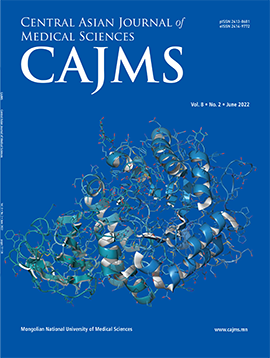Efficacy and Safety of Radiofrequency Ablation for Benign Thyroid Nodules: Initial Mongolian Experience
DOI:
https://doi.org/10.24079/cajms.2022.03.006Keywords:
Radiofrequency Ablation, Thyroid, Nodule, Intervention, TumorAbstract
Objectives: To assess the efficacy and safety of thyroid radiofrequency (RF) ablation for benign thyroid nodules for a 24 months period. Methods: From 2019 to 2021, 485 nodules were from 183 patients (mean age 47.7 ± 11.2) who met eligibility criteria were enrolled from participants. At pre-ablation, the median volume was 0.371 mL (CI 95 %; 0.289 - 0.513). For 1, 3, 6, 12 and 24 months after treatment, 485 lesions, consisting of 258 (27 %) solid, 108 (11.3 %) predominantly solid, 47 (4.9 %) cystic, 25 (2.6 %) predominantly cystic and 47 (4.9 %) sponge were followed. RFA treatment was performed using two standard techniques (trans isthmic and moving-shot) and an RFA V-1000 cooling system. For 24 months, nodule size reduction was assessed. Results: At pre-ablation, the median volume was 0.371 mL (CI 95 % 0.289 - 0.513). For 1, 3, 6, 12 and 24 months after treatment, median volume reduction was 0.263 (CI 95 %; 0.205 - 0.325 p < 0.000), 0.163 (CI 95 %; 0.124 - 0.218 p < 0.000), 0.153 (CI 95 %; 0.074 - 0.194 p < 0.000), 0.148 (CI 95 %; 0.046 - 0.150 p < 0.000), and 0.062 (CI 95 %; 0.006 - 0.111 p < 0.000) respectively. Median volume statistically decreased significantly p = 0.000. Both mean symptom and cosmetic scores showed significant improvements (p < 0.001). All complications were also evaluated during the follow-up. Conclusion: Thyroid RF ablation is an effective and safe treatment modality in patients with benign thyroid nodules. RF ablation may be as effective as surgery if it is performed by experienced physicians in optimally selected patients.
Downloads
245
Downloads
Published
How to Cite
Issue
Section
License
Copyright (c) 2022 Mongolian National University of Medical Sciences

This work is licensed under a Creative Commons Attribution-NonCommercial 4.0 International License.




